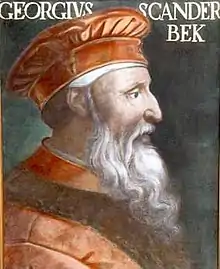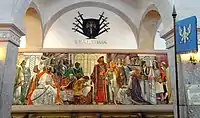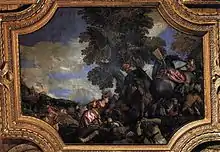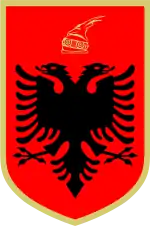League of Lezhë
The League of Lezhë (Albanian: Lidhja e Lezhës) or also commonly referred to as the Albanian League (Albanian: Lidhja Shqiptare or Lidhja Arbërore) was a military and diplomatic alliance of Albanian feudal lords forged in Lezhë on 2 March 1444. The League of Lezhë is considered as the first unified independent Albanian country in the Medieval age, with Gjergj Kastrioti Skanderbeg as leader of the regional Albanian chieftains and nobles united against the Ottoman Empire.[2] Skanderbeg was proclaimed "Chief of the League of the Albanian people" while Skanderbeg always signed himself as "Dominus Albaniae" (Albanian: Zot i Arbërisë, English: Lord of Albania).[3][4]
| League of Lezhë | |
|---|---|
| Lidhja e Lezhës | |
 | |
| Leader | |
| Dates of operation | 1444–1479[1] |
| Active regions | Albania Veneta Sanjak of Albania Sanjak of Dibra |
| Size | 10,000–15,000 |
| Allies | |
| Opponents | |
| Battles and wars | See list |
The main members of the league were the Arianiti, Balsha, Zaharia, Muzaka, Spani, Thopia and Crnojevići. The members contributed to the League with men and money, while Skanderbeg had no right to interfere with the affairs of their domains. All earlier and many modern historians accepted Marin Barleti's news about this meeting in Lezhë (without giving it equal weight), although no contemporary Venetian document mentions it.[5] Barleti referred to the meeting as the generalis concilium or universum concilium ("general council" or "whole council"); the term "League of Lezhë" was coined by subsequent historians.[6]
Background

After the death of Serbian Emperor Stefan Dušan in 1355, the magnates in Albania established their own dominions. When Ottoman forces entered Albania, they were faced with small principalities that were engaged in vicious fights among themselves. The first battle against the Ottoman forces in Albania was that of Balša II, the Lord of Zeta, when one of the Albanian rulers, Karlo Thopia, invited Ottomans who defeated and killed Balša II in the battle of Savra which happened on 18 September 1385.[7][8]
In the 15th century, the Ottoman Empire established itself in the Balkans with no significant resistance offered by local Christian nobles. Many of them were still fighting amongst themselves and didn't see the Ottoman advance as a threat to their power. Although a civil war broke out between Bayezid I's sons in 1402–13, none of the Christian noblemen in the Balkans at the time seized the opportunity to repel the Ottomans; on the contrary, Bulgarians, Serbs and Hungarians even helped the future Sultan Mehmed I seize power, by participating as his allies in the final battle against his brother.[9] After the Ottoman civil war was over in favour of Mehmed I, his forces captured Kruja from the Thopia in 1415, Berat in 1417 from the Muzaka, Vlora and Kanina in 1417 from the widow of Balša III and Gjirokastër in 1418 from the Zenevisi. Under pressure from the Ottoman Empire and the Republic of Venice, the Albanian Principalities began to vacillate.[10] Some Albanian nobility revolted in 1432–36.
In November 1443, Skanderbeg captured Kruja with his troops and declared its independence from the Sultan.[11]
Formation

The League of Lezhë was founded on 2 March 1444 by:[12]
- Lekë Zaharia (lord of Sati and Dagnum), and his vassals Pal and Nicholas Dukagjini
- Pjetër Spani (lord of the mountains behind Drivasto)[13]
- Lekë Dushmani (lord of Minor Pult)[13]
- Gjergj Strez, John and Gojko Balsha (lords of Misia, between Kruja and Lezhë)[13]
- Andrea Thopia (lord of Scuria, between Tirana and Durrës) with his nephew Tanush[14]
- Gjergj Arianiti
- Theodor Corona Muzaka
- Stefan Crnojević (lord of Upper Zeta)[13]
Delegates from Venice were present at the meeting.[3] The military alliance[15] was made up of the feudal lords in Albania, who had to contribute to the League with men and money.[3] Skanderbeg was proclaimed "Chief of the League of the Albanian people".[3][4] Thus, he was the League's leader and commander-in-chief of its combined armed forces numbering 8,000 warriors.[16][17] All the territorial lords had their own domains and affairs; "Skanderbeg had no right to interfere with the affairs of the domains of other nobles", acting only as the supreme military leader, as primus inter pares.[18][19] Barleti referred to the meeting as the generalis concilium or universum concilium ("general council" or "whole council"); the term "League of Lezhë" was coined by subsequent historians.[6]
Initiated and organised under Venetian patronage,[20] through treaties, the league was put under King Alfonso V, with Skanderbeg as captain general.[21]
History
The League's forces had victories against the Ottomans at Torvioll (1444),[22] Mokra (1445),[23] Otonetë (1446),[24] Oranik (1448),[24] a loss at Svetigrad (1448) victory in Polog (1453),[24] victory at Krujë (1450), Albulena (1457), Ohrid (1464), Mokra (1462) and many others.
Skanderbeg first big victory against the Ottomans was at the Battle of Torvioll, the news of the victory of the Christians over the Muslims spread very quickly in Europe. In the two years that followed, the Albanian-Tetan coalition won over the Ottomans. On May 14, 1450, the first siege of Kruja began, which the Ottomans had to end the following year without success. In 1451 Skanderbeg formed an alliance with the Kingdom of Naples for the time being, however, the Albanians received no help from there. In 1452 the Ottomans were defeated at Mokrra and Meçadi. After the fall of Constantinople Albanians received financial aid from Naples and Venice as well as from the Pope. Until 1462, Skanderbeg's troops were able to defeat the Ottomans every year without significantly weakening their superiority. Every year the sultan was able to send a new army without difficulty. Only in 1460 and 1463 did ceasefires interrupt the fighting. In 1462 Skanderbeg succeeded in taking the important city of Ohrid.
In 1466 the second siege of Kruje Castle was knocked down. However, the Ottomans founded the fortress Elbasan south in the valley of the Shkumbin and thus finally settled in Albania. In 1467 a third siege of Kruje failed.

By 1468, the 10,000-strong Skanderbeg army could withstand the Ottomans. The Albanians received financial support from Venice and from the kings of Hungary and Naples. After Skanderbeg died in 1468, the Lezha League began to disintegrate. Following the Venetians, the Northern Albanians in particular continued the fight against the Ottomans. When the Shkodra, which until then had been dominated by the Venetians, was taken by the Ottomans in 1479, the resistance collapsed and the entire Albanian settlement area was incorporated into the Ottoman Empire.
There was also a short-war between Albania and Venice in 1447-1448 but on 4 October 1448, the Albanian–Venetian War ended when Skanderbeg and Nicholas Dukagjini signed a peace treaty with Venice, which would keep its possessions in Albania, including Dagnum, under the conditions that Venice pay a yearly sum of 1,400 ducats, and that some league members would benefit from certain trade privileges, etc.[25]
Dissolution and aftermath

The alliance was precarious.[26] Though an official date of dissolution is unknown, the League of Lezhë fragmented soon after its founding, with many of its members breaking away. By 1450 it had certainly ceased to function as originally intended, and only the core of the alliance under Skanderbeg and Arianiti continued to fight against the Ottomans. Some members preferred to act in line with their own interests. During the attack of the sultan in 1450, they kept changing their position between supporting the Ottomans and joining Skanderbeg.[27] After Pjetër Spani and Gjergj Dushmani left the alliance,[28] and after the Arianiti and Dukagjini left it in 1450, members of Dukagjini family concluded peace with the Ottoman Empire and even began to plot against Skanderbeg.[29]
Skanderbeg commanders
- Gjergj Arianiti
- Nicholas Dukagjini , passed to the Ottomans in 1457
- Pal III Dukagjini , passed to the Ottomans in 1457
- Moisi Arianit Golemi , passed to the Ottomans in 1457
- Hamza Kastrioti , Skanderbeg's nephew, passed to the Ottomans in 1457
- Vladan Jurica, General Quartermaster Skanderbegs
- Vrana Konti
- Peter Perlatai
- Marin Spani
- Andrea Thopia
- Karl Muzak Thopia
- Tanush Thopia
- Ajdin Muzaka
For 25 years, from 1443–68, Skanderbeg's 10,000 man army marched through Ottoman territory winning against consistently larger and better supplied Ottoman forces.[30] Threatened by Ottoman advances in their homeland, Hungary, and later Naples and Venice – their former enemies – provided the financial backbone and support for Skanderbeg's army.[31] After Skanderbeg's death in 1468, the sultan "easily subdued Albania," but Skanderbeg's death did not end the struggle for independence.[32]
Legacy
Part of a series on the |
|---|
| History of Albania |
 |
| Timeline |
The League of Lezhë was the basis for an Albanian state.[33] The formation of the League meant that for the first time Albania was united under an Albanian leader.[34] Some historians regard the League as an independent Albanian state.[35] Others do not accept this view, saying that it was only a military league.[36] However, the League provided the basic elements of Albanian unity.[37]
Skanderbeg and the League of Lezhë have become part of Albanian historiography. That period of history, categorized as a pre-communist time, is seen by many as mythical and unchallengeable. In these cases, struggles against Ottoman and other foreign powers, and processes of national self-definition support the ideological framework linked with that period.[38]
References
- Adrian Brisku (30 August 2013). Bittersweet Europe: Albanian and Georgian Discourses on Europe, 1878-2008. Berghahn Books. p. 21. ISBN 978-0-85745-985-5.
- Babinger, Franz (1992). Mehmed the Conqueror and His Time. Princeton University Press. p. 54. ISBN 0-691-01078-1. Archived from the original on 18 May 2016.
... a solid military alliance was concluded among all the Albanian chieftains along the Adriatic coast from southern Epirus to the Bosnian border.
- Frazee, Charles A. (22 June 2006). Catholics and Sultans: The Church and the Ottoman Empire 1453-1923. Cambridge University Press. p. 33.
- Ednan Aslan; Ranja Ebrahim; Marcia Hermansen (2016). Islam, Religions, and Pluralism in Europe. Springer. p. 237.
- Božić 1979, p. 363
Мада ниједан савремени млетачки документ не помиње овај скуп, сви старији и многи новији историчари прихватили су Барлецијеве вести не придајући им, разуме се, исти значај.
- Biçoku, Kasem (2009). Kastriotët në Dardani. Prishtinë: Albanica. pp. 111–116. ISBN 978-9951-8735-4-3.
- Somel, Selcuk Aksin (2010). The A to Z of the Ottoman Empire. Rowman & Littlefield. p. 14. ISBN 978-0-8108-7579-1. Archived from the original on 1 March 2018.
...the Ottomans supported Lord Carlo Thopia against Balsha II, defeating the latter...
- Gibbons, Herbert Adam (21 August 2013). The Foundation of the Ottoman Empire: A History of the Osmanlis Up To the Death of Bayezid I 1300-1403. Routledge. p. 159. ISBN 978-1-135-02982-1. Archived from the original on 3 December 2016.
...In 1385, Khaireddin pasha... was invited by Charles Thopia, lord of Durazzo, to aid him in a war against Balsa...
- Sedlar 1994, p. 264.
- Frashëri 1964, p. 57
- Noli 1947, p. ?
- Noli 1947, p. 36
- Schmitt 2001, p. 297
Nikola und Paul Dukagjin, Leka Zaharia von Dagno, Peter Span, Herr der Berge hinter Drivasto, Georg Strez Balsha sowie Johann und Gojko Balsha, die sich zwischen Kruja und Alessio festgesetzt hatten, die Dushman von Klein-Polatum sowie Stefan (Stefanica) Crnojevic, der Herr der Oberzeta
- Noli 1947, p. 36
Andrea Thopia of Scuria between Tirana and Durazzo with his nephew, Tanush Thopia
- Sedlar 1994
Even this was loose association of the territorial lords who felt free to go their own way if they so choose. The League functioned only in military domain, never as government, although it did provide the first rudiments of Albanian unity.
- Fox, Robert (1993), The inner sea: the Mediterranean and its people, Alfred A. Knopf, p. 195, ISBN 9780394574523, archived from the original on 13 September 2017
- Vlora, Ekrem Bey (1956), The Ruling Families of Albania in the pre-Ottoman Period in: Contributions to the History of Turkish Rule in Albania: an Historical Sketch, archived from the original on 24 November 2011
- Frashëri 1964, p. 71
Scanderbeg too kept his domain. As president of the League he was merely primus inter pares. He had no right to interfere with the affairs of the domains of other nobles.
- Österreichische Osthefte. Österreichisches Ost- und Südosteuropa-Institut. 2003. p. 123. Archived from the original on 1 March 2018. Retrieved 22 June 2013.
Skanderbeg, der scheinbar dabei war, seine Rolle als primus inter pares zu verlassen und sich zum Herren des ganzen nichtosmanischen Albanien zu machen, stieß auf zunehmenden Widerstand.
- Gibb, Sir Hamilton Alexander Rosskeen; Lewis, Bernard; Pellat, Charles; Schacht, Joseph (1973). The Encyclopaedia of Islam. Brill. p. 139. Archived from the original on 27 May 2013.
- Stavro Skendi (1980). Balkan Cultural Studies. East European Monographs. ISBN 978-0-914710-66-0. Archived from the original on 1 March 2018.
With this network of treaties, the League of Alessio was placed under King Alphonse V, with Skenderbeg as Captain General.78 When Musachi Thopia was apparently reluctant to collaborate with Skenderbeg, the King of Naples reminded him ...
- Frashëri 2002, p. 139.
- Francione 2006, p. 310.
- Francione 2006, p. ?.
- Akademia e Shkencave e Shqipërisë 2002, p. 412
- Georges Castellan (1992). History of the Balkans: From Mohammed the Conqueror to Stalin. East European Monographs. ISBN 978-0-88033-222-4. Archived from the original on 1 March 2018.
In Albania the Ottomans continued to be confronted by Skanderbeg and feudal lords who in 1444 had formed the League of Alessio (Lezha). Yet this was a precarious alliance and ...
- "Oliver Jens Schmitt--Scanderbeg, an Uprising and its Leader". Archived from the original on 13 March 2016.
- Bozbora, Nuray (2002), [[[:sq:Shqipëria dhe nacionalizmi shqiptar në Perandorinë Osmane#search anchor|Shqipëria dhe nacionalizmi shqiptar në Perandorinë Osmane#search anchor]] Shqipëria dhe nacionalizmi shqiptar në Perandorinë Osmane] Check
|url=value (help), Shqipëria: Tirana, p. 79, retrieved 25 September 2012,Por të pafuqishëm për t'i bërë ballë fuqisë së Skënderbeut, si rrugëdalje ata gjetën shkëputjen nga Lidhja. Të parët që ndërmorën një veprim të tillë ishin Pjetër Spani dhe Gjergj Dushmani.
- Frashëri 1964, p. 78.
- Housley 1992, p. 90
- Fine 1994, p. 558
- Lane–Poole, Stanley (1888), The story of Turkey, G.P. Putnam's sons, p. 135, OCLC 398296, archived from the original on 30 May 2016
- Peter F. Sugar (2012) [1st pub. 1977]. Southeastern Europe under Ottoman Rule, 1354-1804. University of Washington Press. p. 67.
- John Van Antwerp Fine (1994). The Late Medieval Balkans: A Critical Survey from the Late Twelfth Century to the Ottoman Conquest. University of Michigan Press. p. 557.
- Pickard, Rob; Çeliku, Florent (2008). Analysis and reform of cultural heritage policies in South-East Europe. Council of Europe. p. 16. ISBN 978-92-871-6265-6. Archived from the original on 28 June 2014. Retrieved 2 February 2012.
- ARMIN HETZER "Die Funktion des Skanderbeg-Mythos für die nationale Identität der Albaner Vom Athleta Christi zum Garanten des laizistischen Staates", in "Abhandlungen der Akademie der Wissenschaften zu Göttingen Neue Folge", Band 12, Walter de Gruyter GmbH & Co. KG: Berlin (2011), p. 108: "In der modernen albanischen Geschichtsschreibung wird mit dieser Liga der Begriff eines „ersten albanischen Staates“ verknüpft und in der westlichen Barletius-Rezeption spricht man ziemlich maßlos vom Königreich Albanien. Tatsächlich war Georg Kastriota zu keinem Zeitpunkt mehr als der Führer eines Zweckbündnisses, ein Primus inter pares. Ein einheitliches albanisches Staatsgebilde hat es vor 1912 nie gegeben und der 1430‒31 gebildete Sancak-i Arvanit umfasste nur den Süden des Landes mit dem Zentrum Gjirokastra (türk. Ergeri, griech. Argyrokastron)."
- Jean W Sedlar, "East Central Europe in the Middle Ages, 1000-1500", University of Washington Press, 1994, p. 26: "Even this was loose association of the territorial lords who felt free to go their own way if they so choose. The League functioned only in military domain, never as government, although it did provide the first rudiments of Albanian unity."
- Marii͡a Nikolaeva Todorova (2004). Balkan Identities: Nation and Memory. C. Hurst & Co. Publishers. p. 104.
Sources
- Barletius, Marinus (1508), Historia de vita et gestis Scanderbegi Epirotarum Principis (in Latin), Bernardinus de Vitalibus, OCLC 645065473
- Božić, Ivan (1979). Nemirno pomorje XV veka (in Serbian). Belgrade: Srpska književna zadruga. OCLC 5845972. Retrieved 12 February 2012.
- Fine, John Van Antwerp (1994), The Late Medieval Balkans: A Critical Survey from the Late Twelfth Century to the Ottoman Conquest, University of Michigan Press, ISBN 978-0-472-08260-5
- Frashëri, Kristo (1964), The history of Albania: a brief survey, s.n., OCLC 1738885
- Housley, Norman (1992), The later Crusades, 1274-1580: from Lyons to Alcazar, Oxford University Press, ISBN 978-0-19-822136-4
- Nicol, Donald MacGillivray (1993), The last centuries of Byzantium, 1261-1453, Cambridge University Press, ISBN 978-0-521-43991-6
- Noli, Fan Stilian (1947), George Castrioti Scanderbeg (1405-1468), International Universities Press, OCLC 732882
- Schmitt, Oliver Jens (2001), Das venezianische Albanien (1392-1479), München: R. Oldenbourg Verlag GmbH München, ISBN 3-486-56569-9
- Sedlar, Jean W. (1994), A history of East Central Europe: East Central Europe in the Middle Ages, 1000-1500, University of Washington Press, ISBN 978-0-295-97290-9
- Setton, Kenneth M. (1976), The papacy and the Levant, 1204-1571: The thirteenth and fourteenth centuries, American Philosophical Society, ISBN 978-0-87169-127-9